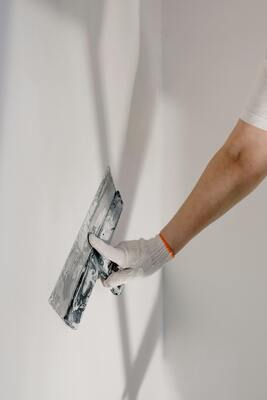
What is Parging: Purpose, Materials, and Techniques for Home Improvement
Many structural and cosmetic problems arise when homeowners and builders don't pay enough attention to the external wall coverings. Without understanding the treatments for these conditions, you risk endangering the safety and worth of your property if no immediate remedies are taken.

What is Parging?
Parging, also known as "parge coating," involves applying a thin layer of cement-based material to the exterior of walls, providing both protection and a polished finish. It forms an effective barrier against moisture, enhancing your property's visual appeal.
This article will explore what parging is, its benefits, and how it can be a game-changer for your home improvement projects.
What is the Purpose of Parging?
Parging acts as a protective barrier against moisture infiltration, preventing mold growth and structural decay while also providing insulation benefits that improve energy efficiency.
Aesthetically, parging gives walls a smooth, finished look, masking imperfections and boosting curb appeal.
Stucco or Parging? Choosing Between the Two
Parging and Stucco are both exterior wall treatments, but they serve different purposes and have distinct characteristics.
Choosing between Stucco and parging depends on your specific needs and project requirements.
Stucco is a more versatile and decorative finish made from a mixture of cement, sand, and lime. It can be applied in thicker layers and is designed to provide both aesthetic appeal and durability. They are commonly used on exterior walls of homes and buildings.
However, it may absorb moisture over time, which can lead to damp surfaces and cracks. Repairing Stucco can also be more challenging due to its thicker layers and porous nature, which often necessitates multiple coats of material to achieve a durable finish.
Compared to parging, Stucco may require frequent maintenance because of its breaking potential, moisture absorption, surface deterioration, and difficulty in repairs.
Unlike Stucco, parging is more functional, providing a protective barrier against moisture and improving insulation. It's typically used on foundations or masonry surfaces where aesthetics are less of a concern. Parging is generally easier to apply and maintain than Stucco.
While both parging and Stucco enhance exterior surfaces, parging is primarily protective and functional, whereas Stucco emphasizes aesthetics and design versatility.
Materials Used for Parging
Parging typically involves a mixture of cement, sand, and water, forming a cementitious mortar. Additional materials may include lime, which enhances workability and durability, and additives that improve adhesion and flexibility. Some standard formulations include:
Cement: The primary binding agent.
Sand: Provides bulk and texture.
Lime: Improves flexibility and reduces shrinkage.
Additives: Such as waterproofing agents or bonding agents such as polyurethane or epoxy to enhance performance.
What is the Best Material for Parging?
A high-quality, pre-mixed parging compound, often with polymer-modified formulations, is ideal. These products offer better adhesion to various substrates and help prevent cracking. For added durability, using a sealer or waterproofing solvent can further extend the lifespan of the parging.
How Parging Works
Parging is a process that involves applying a cement-based coating to masonry surfaces, primarily for protection and aesthetic enhancement. Here's how it works:
Surface Preparation
The first step is to prepare the surface to ensure proper adhesion. This involves cleaning the masonry to remove dirt, dust, and loose materials. Any existing cracks or damage should be filled with grout or an appropriate filler.
Mixing the Parging Compound
A mixture of cement, sand, and water (and possibly lime or polyurethane additives) is prepared to create a workable parging compound. The consistency should be thick enough to adhere to the surface without sagging.
Application
The parging compound is applied using a trowel or a float. It is spread evenly across the surface, typically in a thickness of about 1/4 to 1/2 inch. The application can be done in one or multiple layers or coats, depending on the desired finish and the condition of the surface.
Texturing and Finishing
After application, the surface can be smoothed out or textured according to preference. Various tools can be used to create different finishes, enhancing the visual appeal.
Curing
Once applied, the parging needs to cure properly to develop strength and durability. This typically involves keeping the surface moist for several days to prevent cracking as it dries.
Protection
The final layer of parging acts as a protective barrier against moisture, temperature fluctuations, and other environmental factors, helping to extend the life of the underlying masonry.

What Are the Different Types of Parge?
Parging can be categorized into several types based on the application method and materials used:
Traditional Cement Parging
A basic cementitious mixture of cement, sand, and water is applied to masonry surfaces for protection and insulation.
Polymer-Modified Parging
This type includes epoxy or polyurethane, additives providing flexibility, and durability, making it suitable for various environmental conditions.
Waterproof Parging
Specifically designed with sealer agents to offer extra protection against moisture infiltration.
Decorative Parging
This type focuses on aesthetics, using various textures and colors to enhance the visual appeal of the surface.
Best Practices for Each Type
These best practices for parging can make it work better and last longer:
Traditional Cement Parging
Ensure the surface is clean and free of debris and damp spots to prevent adhesion issues.
Mix the compound to a uniform consistency.
Apply in layers if necessary, allowing for adequate curing time.
Polymer-Modified Parging
Follow manufacturer instructions for mixing and application.
Use a trowel for even application, ensuring good adhesion to the substrate.
Allow for proper curing to maximize the benefits of the polymer additives.
Waterproof Parging
Apply a primer if recommended by the manufacturer to enhance adhesion.
Ensure that the surface is dry before application.
For waterproof parging, apply a second layer or primer to enhance moisture resistance in high-risk areas like basements.
Decorative Parging
Choose the desired texture and finish before application.
Use specialized tools to create patterns or textures.
Seal the surface after curing to protect the decorative finish from the elements.
Can You Parge Over Concrete?
Yes, you can parge over concrete surfaces. However, it is essential to ensure that the concrete is clean, free of any oils, dust, or debris, and in good condition. If the concrete has any cracks or damage, these should be repaired before applying the bonding adhesive to ensure a strong bond between the parging layer and the concrete.
parging material. Additionally, using a bonding agent can enhance adhesion between the concrete and the parging compound.
Can You Parge Over Old Parging?
Yes, you can parge over old parging, provided that the existing layer is sound and well-adhered to the substrate. Before applying new parging, inspect the old layer for cracks, peeling, or other issues. It's also advisable to clean the surface and consider applying a bonding agent to improve adhesion.
If necessary, remove any loose sections and repair any cracks with grout or an appropriate filler before reapplying the new layer.
Maximum Thickness of Parging
Typically, the maximum thickness for parging is about 1/2 inch. Applying thicker layers may require multiple coats to avoid cracking and ensure the material properly adheres to the surface.
If a thicker finish is desired, applying multiple layers is best, allowing each layer to cure adequately before applying the next. This approach helps maintain structural integrity and ensures a durable finish.
Can Parging Be Repaired?
Yes, parging can be repaired by cleaning the damaged area, applying a bonding adhesive, and then patching it with new material. Ensuring proper adhesion to the substrates and a clean surface is essential for long-term durability.
How Long Should Parging Last?
Parging can last between 10 to 30 years, depending on maintenance, material quality, and environmental factors. A well-applied layer with a sealer to protect against moisture can significantly extend its lifespan.
Tips for Extending the Lifespan of Parging
1. Regular Inspections: Check for cracks, moisture issues, or signs of wear and address them immediately.
2. Proper Drainage: Ensure that water drains away from the parged surfaces to prevent moisture buildup, which can lead to damage.
3. Sealant Application: Consider applying a sealant after the parging has cured to protect against moisture and weathering.
4. Avoid Pressure Washing: High-pressure washing can damage the parging surface. Use gentler cleaning methods instead.
5. Repair Promptly: Address any damage or wear as soon as it is noticed to prevent further deterioration.
Benefits of Parging
Parging offers numerous benefits, including enhanced protection for masonry surfaces and improved aesthetics. This durable layer acts as a barrier against moisture, preventing water infiltration that can lead to structural damage.
Additionally, parging contributes to energy efficiency by providing insulation, which can lower heating and cooling costs. By improving the overall appearance of your property, parging can also increase property value, making it an intelligent investment for homeowners.
Conclusion
In summary, parging is a vital home improvement technique that protects masonry surfaces and improves aesthetics. By using high-quality materials, such as polyurethane or epoxy additives, and applying sealer or waterproofing agents, you can ensure that your parging lasts longer and offers excellent protection against moisture. Whether you're looking to enhance curb appeal or safeguard your foundation, parging is an essential part of maintaining your home's integrity.
















.png)
.png)








Leave Your Comment & Rating Below
0 Comment(s)